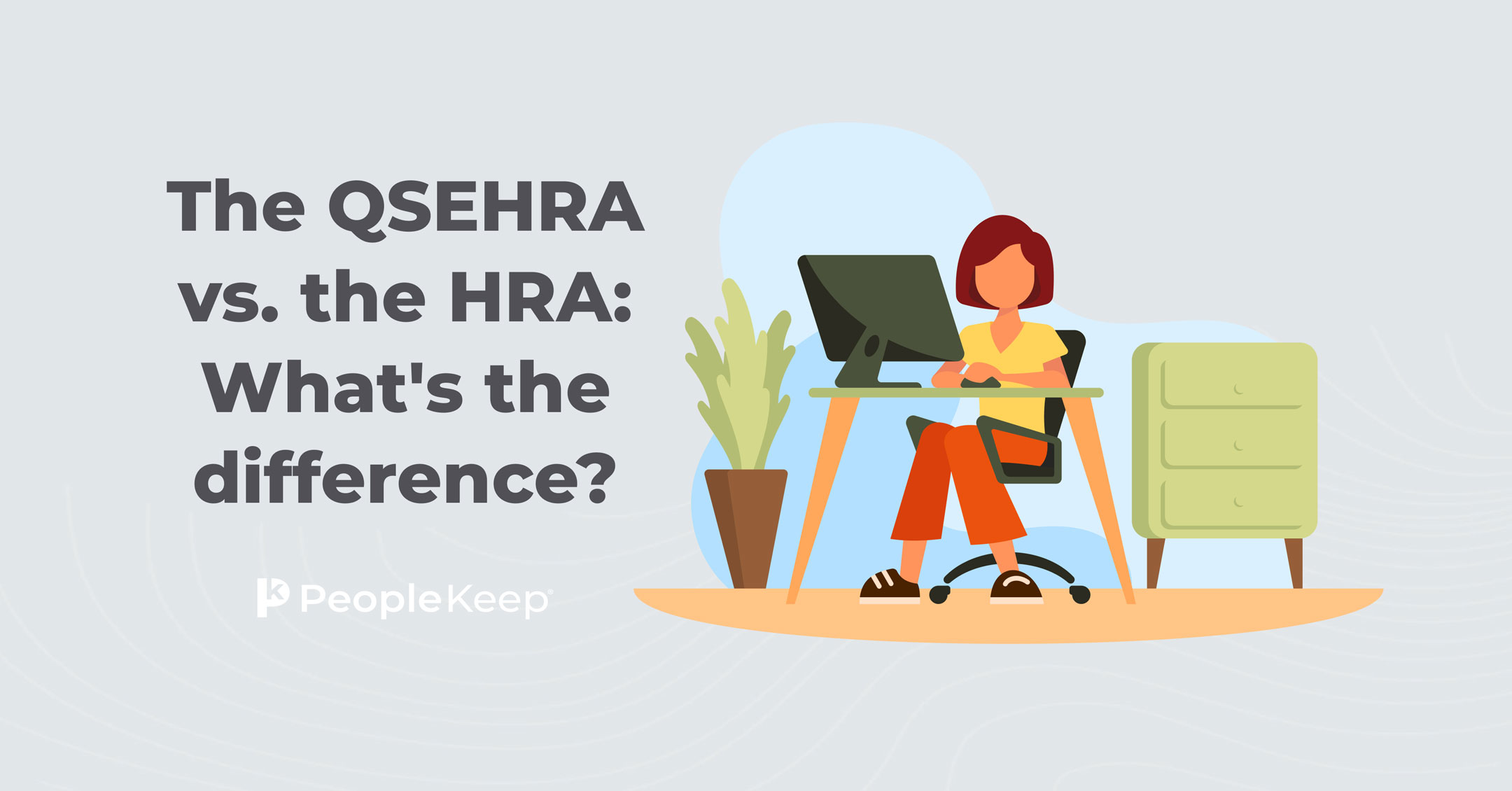Integrated vs. stand-alone HRA
By Elizabeth Walker on June 5, 2023 at 7:25 AM
As healthcare costs continue to rise, some employers are struggling to support their employees' needs while sticking to a reasonable budget. One solution for affordable coverage is a health reimbursement arrangement (HRA), which provides a tax-free and budget-friendly option for organizations.
An HRA is an employer-funded arrangement where you set aside a monthly allowance from which employees can get reimbursed for their out-of-pocket medical expenses without it being treated as taxable income. There are two categories of HRAs: integrated and stand-alone.
Both types of HRAs meet different needs. Deciding which one is right for your organization will largely depend on whether or not you want your HRA to supplement your group health insurance benefit or if you'd like to offer an HRA as its own health benefit.
In this article, we'll go into detail on integrated HRAs and stand-alone HRAs and the different types employers commonly offer.
New to HRAs? Learn which is best for you in our comparison chart
How HRAs work
Before we jump into the different types of HRAs available, let's go over the basics of how an HRA works.
Here's a quick breakdown of how the process works:
- Employers design their benefit. You decide how much tax-free money you’d like to offer your employees as an allowance for their healthcare spending. You'll also decide which expenses are eligible for reimbursement. The IRS defines a complete list of eligible expenses in Publication 502. You can choose to reimburse some and omit others.
- Employees make their healthcare purchases. Your employees purchase medical items and services with their own money.
- Employees submit proof of their incurred expenses. Employees must provide documentation that shows the name of the item or service, its cost, the vendor name, and the date of purchase.
- Employers review and reimburse expenses accordingly. If your employee's purchase is considered a qualified medical expense, you can reimburse your employee up to their accrued allowance amount. Unused funds roll over from month to month.
What is an integrated HRA?
Integrated HRAs are aptly named because they integrate with a traditional group health insurance plan. You can use them to supplement your group plan by reimbursing employees for out-of-pocket medical expenses that aren’t fully covered by their plan.
Common types of eligible reimbursable expenses with an integrated HRA include copays, co-insurance, and medical care expenses paid before the deductible is met.
If you have a traditional group health plan or are considering signing up for one, the two types of integrated HRAs we'll discuss below will be the most beneficial to you.
Excepted benefit HRA (EBHRA)
The first type of integrated HRA is an excepted benefit HRA (EBHRA). An EBHRA allows employees to get reimbursed for additional—or excepted—medical care that isn't included in traditional health insurance plans.
This includes dental and vision care, accident and disability insurance, long-term care benefits, and other out-of-pocket healthcare costs not fully covered by their primary group plan.
You can’t use EBHRAs to cover individual medical insurance premiums, group plan premiums (other than COBRA), or Medicare premiums. However, you can use an EBHRA to reimburse premiums for individual or group health plans that consist solely of excepted benefits, such as dental or vision insurance.
It's important to note that this benefit comes with an annual contribution maximum. What's more, while an EBHRA must be offered with a traditional group health plan, employees aren't required to enroll in the group plan in order to participate in the EBHRA. You must offer the benefit to all employees equally.
An EBHRA is a good choice for employers that:
- Want to offer a supplemental health benefit to employees regardless of their enrollment in their traditional group health plan
- Want a fixed annual contribution limit
- Don't want to offer different allowances or benefits to separate employee classes
Group coverage HRA (GCHRA)
Similarly to EBHRAs, the group coverage HRA (GCHRA) allows employers of all sizes to reimburse employees for their medical expenses. However, unlike an EBHRA, a GCHRA can only be offered to employees who are enrolled in your group health insurance plan.
GCHRAs are typically used with a high deductible health plan (HDHP) to cover employees' high deductible expenses, but they can work with any traditional group health plan.
Using the GCHRA, you set a reimbursement allowance for employees to use each month toward 200+ eligible expenses. There is no annual contribution limit, so the allowance can be as big or little as your budget allows. However, you can’t reimburse insurance premiums with a GCHRA—not even premiums for excepted benefits like dental or vision care.
A defining quality of a GCHRA is that employers can choose exactly how they want to customize their benefit by creating employee classes. For example, you could have one group made up of hourly employees and another of salaried employees, and offer each of these groups a different allowance amount. You can also define separate HRA deductibles and cost-sharing requirements for each group.
A GCHRA is a good choice for employers that:
- Have an HDHP and want to offset their employees' out-of-pocket healthcare costs
- Want to offer a higher allowance to their employees on a group plan than the EBHRA contribution limits allow
- Want to offer different benefits to different employees using employee classes
What is a stand-alone HRA?
Unlike integrated HRAs, stand-alone HRAs aren’t linked to a traditional group health plan. Instead, stand-alone HRAs are typically leveraged as an alternative to group health insurance and as the singular health benefit for an employer.
With this type of HRA, an employer provides employees a fixed monthly allowance that they can use toward their own individual health insurance premiums and other qualified out-of-pocket expenses.
The two most popular stand-alone HRAs are the qualified small employer HRA (QSEHRA) and the individual coverage HRA (ICHRA). If you're looking for a cost-effective, personalized health benefit, these two HRAs might be just what you need.
Qualified small employer HRA (QSEHRA)
A qualified small employer HRA (QSEHRA) is for employers with fewer than 50 full-time equivalent employees (FTEs). With a QSEHRA, employers set an allowance for employees to use on individual health insurance premiums and other qualifying expenses. After you verify the expense, you reimburse your employees up to their allowance amount.
The QSEHRA has maximum contribution limits that are updated annually by the IRS but no minimum contribution limits. Reimbursements are free of payroll tax for the employer and, in most cases, for their employees. Reimbursements are also free from employee income tax as long as their policy provides minimum essential coverage (MEC). Any unused amount for the month will roll over to the following month until the end of the year. Any unused funds left at that point will go back to the employer, making it even more cost-effective for your organization.
With a QSEHRA, your employees who receive financial assistance through premium tax credits can't choose to opt out of the benefit and waive future reimbursements to collect their full premium tax credit. Instead, they have to lower their credit, dollar-for-dollar, by the monthly HRA funds you offer.
A QSEHRA is a good choice for employers that:
- Have fewer than 50 employees and are looking for an alternative to group health insurance
- Have employees with various insurance coverage situations, such as individual coverage and employees under a parent’s or spouse’s insurance
- Don't need to offer more than the annual contribution limit allows
Individual coverage HRA (ICHRA)
Though similar to the QSEHRA, the ICHRA does have a few notable differences. An ICHRA is available to employers of all sizes and can be offered as a stand-alone benefit or offered to employees who aren't offered your traditional group health plan.
ICHRAs also set themselves apart from QSEHRAs with their flexibility to designate different employee classes. This allows employers to offer different allowance amounts to their full-time, part-time, or out-of-state employees, just to name a few.
As with a QSEHRA, employers offer their employees a monthly allowance. Employees purchase individual coverage and other qualified medical care expenses, and you reimburse them up to their allowance amount. All ICHRA reimbursements are also free of both payroll tax and income tax.
If your organization offers an ICHRA, employees will have the option to opt in or out of your benefit. If they decide to participate in the ICHRA, employees must have a qualifying form of individual health insurance coverage and attest they are covered by that policy before they can collect future reimbursements.
Also, your employees who collect premium tax credits will be affected by an ICHRA. Ultimately, they'll have to choose between one or the other. If you offer an allowance that's considered affordable, they have to give up their premium tax credits. However, if you offer an unaffordable allowance, they can opt out of the ICHRA and continue receiving their tax credits.
An ICHRA is a good choice for employers that:
- Have more than 50 FTEs and need to satisfy the Affordable Care Act (ACA)’s employer mandate
- Want to offer different benefits to a certain class of employees
- Want to offer more than the QSEHRA contribution limits allow
- Want to offer a traditional group health plan to some employees and an HRA to others
How PeopleKeep can help
While it's possible to administer an HRA on your own, it can be complex, confusing, or time-consuming for busy employers who are also trying to run a small or medium-sized business.
By using HRA administration software like PeopleKeep, you can manage your benefit in a matter of minutes each month. We take care of required plan documents and compliance, and ensure your employees use the money you set aside as intended. Keeping HIPAA’s privacy rules in mind, our experts carefully review your employees’ submissions for you so you can be sure it qualifies for reimbursement.
With PeopleKeep, we can help you set up and manage a:
Conclusion
Gone are the days when your only benefits option was working with an insurance company to find a group health plan that didn't break the bank. HRAs provide flexibility for employers along with tax benefits. Plus, HRAs provide a richer health benefit for employees, which can help to improve your organization's recruitment and retention efforts.
Whether you’re looking to supplement a group health plan or offer an affordable alternative to group health insurance, HRAs are a personalized and customizable way to get the job done.
This article was originally published on February 2, 2022. It was last updated on June 5, 2023.
Check out more resources
See these related articles

The QSEHRA vs. the HRA: What's the difference?
Confused about the difference between an HRA and a QSEHRA? This guide explains how a QSEHRA compares to other types of HRAs.

The history of health reimbursement arrangements (HRAs)
Explore the history of Health Reimbursement Arrangements (HRAs) and learn when HRAs were created and how they've evolved over the years.

Pros and cons of the individual coverage HRA
Considering an individual coverage HRA (ICHRA)? Discover the pros and cons of this healthcare option to make an informed decision.


